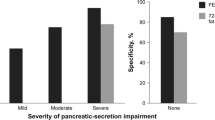Abstract
Background
Measurement of pancreatic exocrine function and steatorrhea in chronic pancreatitis in the clinical setting has not received much attention.
Aim
To assess pancreatic exocrine function and fecal fat excretion in a cohort of patients with chronic pancreatitis.
Methods
Stool elastase1 levels were measured in 101 patients using polyclonal ELISA and acid steatocrit was measured in 86 chronic pancreatitis patients. Associations with etiology, clinical and radiological features, and diabetic status were examined.
Results
Low pancreatic stool elastase1 (<200 μg/g stool) was observed in two-thirds of chronic pancreatitis patients and correlated with ductal dilatation, pancreatic atrophy and calcification (p<0.05). Diabetes was more prevalent in chronic pancreatitis patients with low elastase1 (p=0.045). There was no difference in mean acid steatocrit between diabetics and non-diabetics (p=0.069). Elastase1 levels had a negative correlation with acid steatocrit (r=−0.606, p<0.001), and a positive correlation (r=0.412) with body mass index (p=0.013). Fiftythree percent of chronic pancreatitis patients with normal BMI had low elastase1.
Conclusions
Fecal elastase1 levels correlated with fecal fat excretion and BMI. Fecal elastase1 estimation may be helpful in early detection of malabsorption in chronic pancreatitis.
Similar content being viewed by others
References
Lüth S, Teyssen S, Forssmann K, Kölbel C, Krummenauer F, Singer MV. Fecal elastase-1 determination: ‘gold standard’ of indirect pancreatic function tests? Scand J Gastroenterol 2001;36:1092–1099.
Keim V, Teich N, Moessner J. Clinical value of a new fecal elastase test for detection of chronic pancreatitis. Clin Lab 2003;49:209–215.
Naruse S, Ishiguro H, Ko SB, et al. Fecal pancreatic elastase: a reproducible marker for severe exocrine pancreatic insufficiency. J Gastroenterol 2006;41:901–908.
Hahn JU, Bochnig S, Kerner W, et al. A new fecal elastase 1 test using polyclonal antibodies for the detection of exocrine pancreatic insufficiency. Pancreas 2005;30:189–191.
Van de Kamer JH, Huinink HB, Weyers HA. Rapid method for determination of fat in feces. J Biol Chem 1949;177:347–355.
Amman ST, Josephson SA, Toskes PP. Acid steatocrit: a simple gravimetric method to determine steatorrhea. Am J Gastroenterol 1997;92:2280–2284.
Balakrishnan V, Unnikrishnan AG, Thomas V, et al. Chronic pancreatitis. A prospective nationwide study of 1,086 subjects from India. JOP 2008;9:593–600.
Tran M, Forget P, Van den Neucker A, Strik J, van Kreel B, Kuijten R. The acid steatocrit: a much improved method. J Pediatr Gastroenterol Nutr 1994;19:299–303.
Bijoor AR, Geetha S, Venkatesh T. Faecal fat content in healthy adults by the acid steatocrit method. Indian J Clin Biochem 2004;19:20–22.
George PK, Banks PA, Pai KN, Ramachandran M, Thangavelu M, Tandon BN. Exocrine pancreatic function in calcific pancreatitis in India. Gastroenterology 1971;60:858–863.
Balakrishnan V, Sauniere JF, Hariharan M, Sarles H. Diet, pancreatic function, and chronic pancreatitis in south India and France. Pancreas 1988;3:30–35.
Balakrishnan V, Hareendran A, Nair CS. Double-blind crossover trial of an enzyme preparation in pancreatic steatorrhoea. J Assoc Physicians India 1981;29:207–209.
Patel VP, Jain NK, Agarwal N, GeeVarghese PJ, Pitchumoni CS. Comparison of bentiromide test and rice flour breath hydrogen test in the detection of exocrine pancreatic insufficiency. Pancreas 1986;1:172–175.
Chari S, Mohan V, Snehalatha C, et al. Faecal chymotrypsin assay in tropical and alcoholic chronic pancreatitis. Trop Gastroenterol 1990;11:144–147.
Lankisch PG, Schmidt I, Konig H, et al. Faecal elastase 1: not helpful in diagnosing chronic pancreatitis associated with mild to moderate exocrine pancreatic insufficiency. Gut 1998;42:551–554.
Whitcomb DC. Hereditary, familial, and genetic disorders of the pancreas and pancreatic disorders in childhood. In: Feldman LS, Friedman LS, Brandt LJ (eds). Gastrointestinal and Liver Disease, 8th ed, Saunders, Philadelphia, 2006; p. 1227.
Punnose J, Balakrishnan V, Bhadran A, Krishnadas KV. Exocrine pancreatic function in chronic pancreatitis with and without calcification. Indian J Gastroenterol 1987;6:85–86.
Chawla LS, Sehgal AK, Verma RS, Balakrishnan V, Chuttani PN. Lundh test in the diagnosis of exocrine pancreatic insufficiency. Indian J Med Res 1973;65:700–703.
Balakrishnan V, Nair P, Radhakrishnan L, Narayanan VA. Tropical pancreatitis-a distinct entity or merely a type of chronic pancreatitis? Indian J Gastroenterol 2006;25:74–81.
Author information
Authors and Affiliations
Corresponding author
Rights and permissions
About this article
Cite this article
Girish, B.N., Rajesh, G., Vaidyanathan, K. et al. Fecal elastase1 and acid steatocrit estimation in chronic pancreatitis. Indian J Gastroenterol 28, 201–205 (2009). https://doi.org/10.1007/s12664-009-0079-z
Received:
Revised:
Accepted:
Published:
Issue Date:
DOI: https://doi.org/10.1007/s12664-009-0079-z




